Serviços Personalizados
Artigo
Links relacionados
Compartilhar
RGO.Revista Gaúcha de Odontologia (Online)
versão On-line ISSN 1981-8637
RGO, Rev. gaúch. odontol. (Online) vol.58 no.2 Porto Alegre Abr./Jun. 2010
CLINICAL CLÍNICO
Diastemas: reestablishment of an attractive smile
Diastemas: restabelecimento da harmonia do sorriso
Mara Antônio Monteiro de CastroI; José Carlos Monteiro de CastroII; Denise PedriniII, *; Sônia Regina PanzariniII; Wilson Roberto PoiII
IUniversidade Estadual Paulista Júlio de Mesquita Filho, Faculdade de Odontologia, Departamento de Odontologia Restauradora. Araçatuba, SP, Brasil
IIUniversidade Estadual Paulista Júlio de Mesquita Filho, Faculdade de Odontologia, Departamento de Cirurgia e Clínica Integrada. Rua José Bonifácio, 1193, Vila Mendonça, 16015-050, Araçatuba, SP, Brasil
ABSTRACT
A healthy and attractive smile is very valued in today's society. Yet this requires better aesthetic and cosmetic solutions from dental surgeons. The present paper presents a case report of diastema closure using an association of tooth movement induced by orthodontic elastics, dental cosmetics and resin-bonded prosthesis. The female patient L.B.A.J., aged 19 years, visited the Integrated Clinic of Araçatuba Dental School – UNESP mainly complaining of missing teeth and poor esthetics. After anamnesis, clinical and radiographic examination revealed hypodontia of the maxillary right and left first premolars, abnormal maxillary right lateral incisor shape and diastema between the maxillary right lateral incisor and canine and between the maxillary left lateral incisor and canine. Planning was done which included indication of diastema closure with composite resin restoration and metal-free resin-bonded prosthesis, with a structure made of Vectris (Ivoclar Vivadent Inc., Amherst, NT, USA). The option for dental cosmetics associated with resin-bonded prosthesis after movement with orthodontic elastics resulted in an excellent aesthetic outcome of low cost and short treatment duration.
Indexing terms: composite resins; diastema; fixed resin bonded partial denture.
RESUMO
Ter um sorriso saudável e harmônico representa grande valor na sociedade atual. Para esta condição, exigem-se melhores soluções estéticas e cosméticas pelos cirurgiões-dentistas. O objetivo deste artigo é apresentar um caso clínico de fechamento de diastema utilizando a associação da movimentação dentária por meio de borrachas ortodônticas, com a plástica dentária e a prótese fixa adesiva. Paciente L.B.A.J., sexo feminino, 19 anos, procurou o serviço da Clínica Integrada da Faculdade de Odontologia de Araçatuba da Universidade Estadual Paulista Júlio de Mesquita com queixa de ausência de dentes e estética comprometida. Após anamnese, exame clínico e radiográfico foi diagnosticado agenesia dos dentes 14 e 24, alteração de forma do 12 e diastema entre o 12 e 13 e o 22 e 23. Foi realizado o planejamento, com indicação de fechamento de diastema, com restauração de resina composta e prótese fixa adesiva sem metal, com estrutura em Vectris (Ivoclar Vivadent Inc., Amherst, NT, USA). A opção pela plástica dentária associada à prótese fixa adesiva, após movimentação com borrachas, mostrou-se um excelente resultado estético com menor custo e tempo de tratamento.
Termos de indexação: resinas compostas; diastema; prótese adesiva.
INTRODUCTION
Teeth appearance has been increasingly valued by society and people are giving higher priority to a healthy and attractive smile1.
The traditional work of dental professionals, focused on the elimination of oral diseases, now includes another field: the improvement of appearance. However, health fundamentals, proper function and correct scientific principles should prevail1.
Diastemas are a frequent aesthetic problem classified as an anomaly of multiple etiologies that causes permanent discomfort to patients that regard them as unacceptable, and a challenging task for professionals2-3.
As the media increases the awareness of the population regarding possible aesthetic-cosmetic solutions and the current status of restorative materials, patients are increasingly demanding aesthetic and cosmetic solutions for tooth shade, texture, shape and position3.
Other factors that should be considered when improving a smile include treatment duration and cost, which are essential for planning a treatment.
Thus, the present paper presents a case report of diastema closure using an association of dental cosmetics, resin-bonded prosthesis and tooth movement with orthodontic elastics.
CASE REPORT
The female patient L.B.A.J., aged 19 years, visited the Integrated Clinic of Araçatuba Dental School, UNESP - Univ Estadual Paulista mainly complaining of missing teeth and poor aesthetics. After anamnesis, clinical and radiographic examination revealed hypodontia of the maxillary right and left first premolars (Figure 1), abnormal maxillary right lateral incisor shape (Figure 2) and diastema between the maxillary right lateral incisor and canine and between the maxillary left lateral incisor and canine (Figures 2 and 3). The treatment plan included an indication of closing the diastema with composite resin restoration and metal-free resin-bonded prosthesis made with Vectris (Ivoclar Vivadent Inc., Amherst, NY, USA).
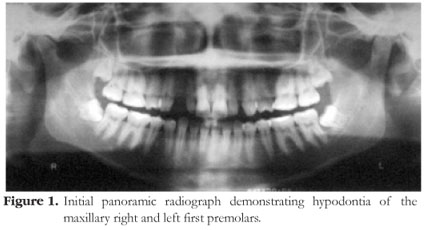
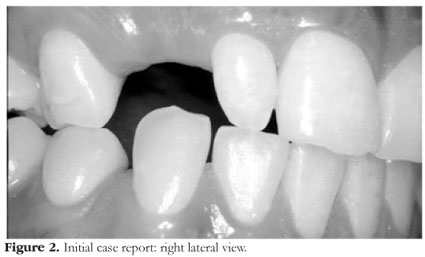
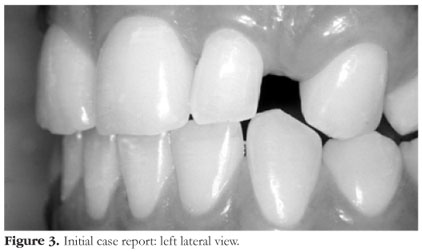
Before diastema closure, orthodontic elastics (Figure 4) were used to divide the available space, allowing a more attractive restoration without midline deviation. Restoration of the maxillary right and left central and lateral incisors and canines was performed with a microhybrid composite resin shade A2 (Palfique Estelite, Tokuyama Corp./J. Morita USA, Inc., Irvine, CA, USA) (Figure 5). After diastema closure, the remaining space was filled with a resin-bonded prosthesis (Targis, Vectris, Ivoclar Vivadent Inc., Amherst, NY, USA).
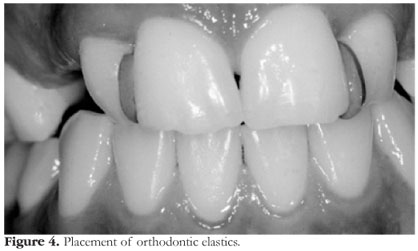
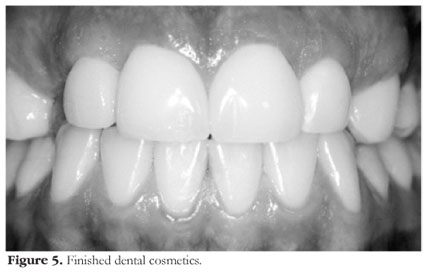
For the laboratory to fabricate the prosthesis, inlay preparations were done on the maxillary right lateral incisor and canine, and an impression was taken with polyether (Impregum Soft, 3M ESPE, St. Paul, MN, USA).
After placement of the rubber dam, the appliance was luted with resin cement (RelyX CRA, 3M ESPE, St. Paul, MN, USA) (Figure 6).
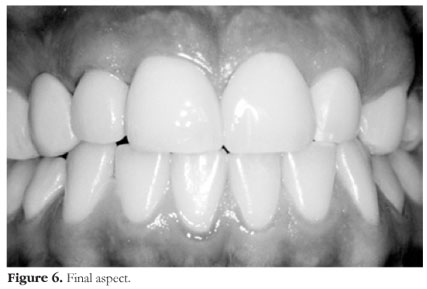
DISCUSSION
Diastemas due to missing teeth or hypodontia may be orthodontically closed and/or reconstructed with fixed dentures4, removable dentures or implants3.
Dental osseointegrated implants have been considered successful worldwide and all longitudinal studies corroborate this fact5-8. One of the main advantages of implants is the rehabilitation of the edentulous space with maintenance of the height and width of the alveolar bone9; however, cost has been their major drawback.
As the industry evolved and developed new materials, there was an increase in the flexural strength of these materials, which allowed the indication of fiber-reinforced ceramics or resins for these restorations. Other cases may be treated by directly bonded restorative procedures after redistribution of the available space.
Diastemas due to discrepancies in the shape and size of teeth have a very favorable prognosis for restorative and prosthetic treatment3. However, clinical planning should thoroughly investigate the patient's characteristics to achieve a good prognosis, such as his/her occlusion, length of edentulous space, occlusal height of abutment teeth, and presence of parafunctional habits10.
Thus, as in the present case report, group function, small edentulous space, absence of parafunctional habits and favorable status of the abutment teeth allowed indication of dental cosmetics associated with a metal-free prosthesis (Targis, Vectris, Ivoclar Vivadent Inc., Amherst, NY, USA), providing proper distribution of stress for the reestablishment of function and aesthetics at low cost when compared with orthodontic treatment.
The main drawback in the present case was the socioeconomic status of the patient, which did not allow an ideal solution. The advantage of this type of indication is the lower cost and possibility of reversing the treatment with direct composite resin restoration on the abutment teeth and replacement of the adhesive denture by an implant.
Problems of multiple anterior diastemas may be solved by teamwork, when more than one discipline comes together to complement and improve the outcome that could be reached by each specialty by itself. Coinciding dental and facial midline, especially in the maxillary arch, is esthetically essential for the restoration of a pleasant smile. The key to success is the correct positioning of the teeth to be restored11. The present case did not present midline deviation, so tooth positioning could be corrected in a simple and fast manner by placement of orthodontic elastics for better space distribution, which contributed to a better outcome of the restorative treatment.
With the recent improvements in shade stability and bond strength, diastemas may be closed simply by direct placement of restorative material, with the advantages of reversibility, reduced cost and short treatment duration12.
In many instances, the socioeconomic status of the patient leads the dental professional to search for alternative options for solving aesthetic problems without changing the function.
CONCLUSION
Due to the interrelationship of the procedures involved in diastema treatment, patients without midline deviation may be treated by general practitioners in an easy, fast and inexpensive manner, and expect a very favorable aesthetic outcome.
Collaborators
The authors worked as a team for the diagnosis, treatment plan and case control. MAM CASTRO was the clinician responsible for the dental restoration. JCM CASTRO was the clinician responsible for the dental prosthesis. D PEDRINI wrote this paper together with SR PANZARINI and WR POI.
REFERENCES
1. Cunningham R. Perspectives: solutions gap looms for financing baby boomers´ future long-term care needs. Med Health. 1998;52(12):1-4. [ Links ]
2. Jenny J, Cons NC, Kohout FJ. Relationship between dental esthetics and attributions of self-confidence. J Dent Res. 1990;69:204. [ Links ]
3. Mondelli J, Pereira MA, Mondelli RFL. Etiology and treatment of dental diastema. Biodonto. 2003;1:11-46. [ Links ]
4. Rosenberg J. Conservative anterior reconstruction: a combined technique approach. Dent Today. 1997;16(4):92-93. [ Links ]
5. Adell R, Lekholm U, Rocler B, Branemark, P-I. A 15 year study of osseointegrated implants in the treatment of the edentulous jaw. Int J Oral Surg. 1981;10(6):387-416. [ Links ]
6. Adell R, Lekholm U, Rocler B, Branemark P-I, Jemt T. A long term follow up study of osseointegrated implants in the treatment of the edentulous jaw. Int J Oral Maxillofac Implants. 1990;5(4):347-59. [ Links ]
7. Zarb GA, Schmitt A. The longitudinal clinical effectiveness of a osseointegrated dental implants. The Toronto study. Part I Surgical results. J Prosthet Dent. 1990;63(4):451-7. [ Links ]
8. Zarb GA, Schmitt A. The longitudinal clinical effectiveness of a osseointegrated dental implants. The Toronto study. Part II Problems and complications encountered. J Prosthet Dent. 1990;64(2):185-94. [ Links ]
9. Misch CM, Misch CE. Intraoral autogenous donor bone grafts for implant dentistry. In: Misch CE. Contemporary implant dentistry. 2nd edn. St. Louis: Mosby; 1999. p.497-508. [ Links ]
10. Pires LAG, Conceição EN. Prótese adesiva em dentes posteriores. In: Conceição EN. Dentística: saúde e estética. Porto Alegre: Artmed; 2000. p.311-21. [ Links ]
11. Gribble AR. Multiple diastema management: an interdisciplinary approach. J Esthet Dent. 1994;6(3):97-102. [ Links ]
12. Guess MB, Solzer WV. Computer-generated diagnostic correction of anterior diastemas. J Prosthet Dent. 1988;59(5):629-32. [ Links ]
Recebido em: 23/5/2008
Aprovado em: 28/7/2009
* Correspondência para / Correspondence to: D PEDRINI. E-mail: <pedrini@foa.unesp.br>













